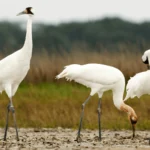
The third Friday in May marks the annual celebration of National Endangered Species Day. This year is extra special as the U.S. Endangered Species Act (ESA) is celebrating 50 years of protecting and recovering Endangered and Threatened species and their habitats.
In celebration of this milestone, the Fondo de Acción de la Conservación Americana de Aves, the 501(c)(4) affiliate of American Bird Conservancy (ABC), produced the “Celebrating 50 Years of the Endangered Species Act” report, which details the ESA’s legacy, successes, and future. The report underscores the importance of upholding the ESA to protect birds facing unprecedented threats.

“"El Águila calva, Peregrine Falcon, Reinita de Kirtland, Hawaiian Hawk (‘Io) and Interior Charrán mínimo have all been delisted due to successful recovery efforts,” said Steve Holmer, Vice President of Policy for American Bird Conservancy (ABC). “As ABC’s 2016 ESA Recovery report found, once listed, birds usually start back on the roads towards recovery with most populations increasing or at least stable.”
President Richard Nixon signed the ESA into law on December 28, 1973. The report explains how over the past half-century, the ESA has served as a vital tool for conserving avian species in the United States, including birds such as the Grulla trompetera y Cóndor de California, which would likely have gone extinct without actions taken under the ESA.
However, the report also outlines cases in which the ESA has fallen short for certain bird species. More than two dozen listed avian species are still in decline today, including the Gunnison Sage-Grouse, mérgulo jaspeado, Nudo rojo, and several Hawaiian forest birds. And not all U.S. species in decline have been granted ESA protections, such as the Urogallo de las artemisas.
There are also threats to birds and other wildlife that the Environmental Protection Agency (EPA) could take stronger action on, such as insecticides and rodenticides. Ninety-five percent of chemical pesticides have not undergone legally required ESA consultations, even though insecticides like neonicotinoids are known to be deadly to birds, and rodenticides can be harmful to Endangered species like the California Condor. Hearteningly, the report outlines how the EPA has begun working to address these threats.
“The ESA has been critical to protecting birds and their habitats, and is needed more than ever as Threatened and Endangered species are increasingly exposed to toxic pesticides,” said Hardy Kern, ABC Director of Government Relations, Birds and Pesticides Campaign. “Further loss of irreplaceable species and their habitat can be avoided by thoroughly evaluating toxic chemicals and limiting the application of those found to pose a threat to endangered species.”
The 50th anniversary of this landmark act is a time for reflection, celebration, and renewed advocacy on behalf of the ESA. With continued dedication, ABC will work to conserve birds and their habitats, helping to ensure that the ESA can stand up to emerging threats and protect species at risk of being lost forever.
###
Conservación de Aves de Estados Unidos ABC emprende acciones decisivas para conservar las aves silvestres y sus hábitats en todo el continente americano. Inspirados por la fascinación de las aves, logramos resultados duraderos para las especies más necesitadas, beneficiando a la vez a las comunidades humanas, la biodiversidad y el frágil clima del planeta. Cada una de nuestras acciones se fundamenta en la ciencia, se fortalece mediante alianzas y se basa en la convicción de que la diversidad de perspectivas genera resultados más sólidos. Fundada como organización sin fines de lucro en 1994, ABC mantiene su compromiso de proteger a las aves para las generaciones futuras. ¡Únete a nosotros! Juntos podemos hacer más para asegurar que las aves prosperen.
Contacto con los medios
Jordan Rutter
Director de Comunicaciones
media@abcbirds.org